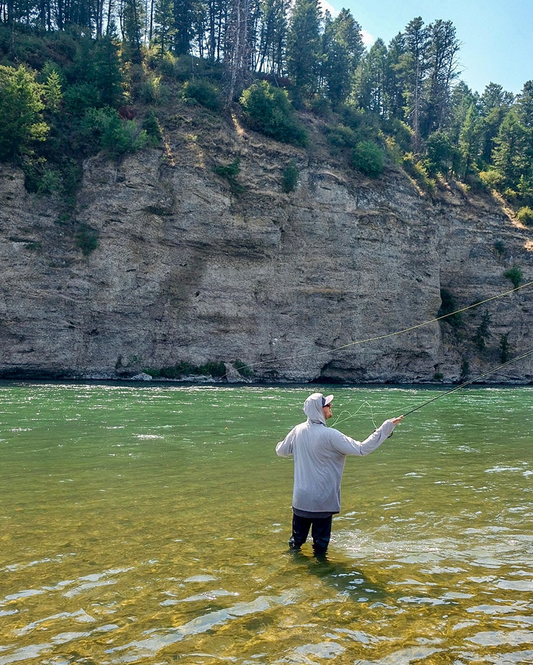Arguably the best moment in fishing, the climax event when everything invested transforms to tangible result is the landing of a fish. Such a key component of catching fish is greatly aided by a successful net job. It's a part of fishing discipline that's often under appreciated, yet I think it's just as important as the cast. In a flash, the act of netting a fish can turn into an absolute gong show, quickly separating the veteran pros from the unseasoned rookies. As an isolated skill set in itself, netting fish involves practice, observation and technique. When done right it's a thing of beauty and grace, as impressive as a perfect cast. When done wrong, it quickly turns into a comedy of flailing, cursing, splashing and failure. Here are a few of my thoughts of why nets are important (especially for catch & release scenarios and photography) and some tips to help along the way.
Bring more fish to hand- Imaging you've hooked the fish of a lifetime. It's kicking your ass and you are praying you'll find a way to land the beast. It's a no-brainer, a net is going to be a key part of this situation and the fellow who's developed good netting skills has a big advantage. Without question a net allows an angler to get that fish secured as "landed" faster and with higher success than an angler trying to play a fish to they point they can secure it in their hands or pin it to the bank. My preference is a net with a deep rubber bag and long handle which allows for aggressive scoops at fast moving opportunities.
Land 'em faster- Beyond the advantage of higher landing rates, it's important to get fish in and released as soon as possible. Especially true in warmer conditions, the faster a fish is landed, revived and released the better it's chance of survival. A fish that's played to exhaustion is at increased risk of dying shortly after release. These are great reasons to take your game up a notch, put the wood to 'em and fight fish aggressively. It's fun to add this new dimension to fishing, putting yourself to the test to see just how fast you can get a fish in.
Land 'em in deeper water away from rocks- Without a net, anglers are often working to get fish to the bank to try and grab, or worse yet tossing fish up onto the bank. If the catch is expected to be released- and live, this is a bad deal. You wouldn't do well smashing your melon on the rocks, so why would a fish? This is a key reason nets help catch & release fish survive.
Keep 'em wet, in the net- Something I view as rookie practice, are anglers that get a fish in their net, then for some reason feel like they need to hold the net high up in the air with the fish gasping in the wind- as if the fish is somehow going to swim away? Make it a habit to keep the fish in the water once it's netted. This is a crucial time for fish survival, and there's simply no reason the fish can't be recovering in the water 100% of the time it's in your possession.
Get better photos- You've landed the slab of a lifetime, sure to bring you social media fame and fortune. But not without a great photo first right? With your precious trophy now in the penalty box, what could be an ongoing disaster is instead a chance to gather your camera and composure and prepare your epic photos all while the fish is breathing & recovering in the net, in the water. Perfect!
I like to get my camera down close for a few detail shots of the fish in the net, partially in or just above water. Try taking shots of the fish actually under water. With a little practice you'll figure out that killer shots are there just waiting for you to find them. If you're going to quickly lift the fish for a grip n' grin, use an "A-Okay" formation with your fingers around the wrist of the tail, then support the front of the fish with the other hand. Don't squeeze! Vital organs lie low in the front of a fish and can easily be torn or crushed by someone gripping too hard. Keep the fish over the water so that when it flops (they almost always do) it can go right back in the floating net in the water. I think the best practice is to multi task this process and simply get these photos while in the act of reviving and releasing the fish. Point the fish into the current, and let it circulate water through it's gills till it's ready to split. You'll be able to tell when it's ready to go. This is important because an exhausted fish that's just tossed back into the water without revival can drift into stagnant areas and never recover.
Netting Tips- Ever hook a fish and have it run strait at you and zip right past your feet? From the first moment a fish is hooked there are opportunities to net it. Thats why the first thing I'd suggest is to keep your net somewhere you can grab it quick draw fashion. I use long handle nets because I can keep them in my belt, ready to grab and dip in seconds.
Upstream fight, downstream net. I like to use the current to my advantage when playing fish. This means working to steer the fish into softest water possible anytime it's down stream of me, and into heavy water if it's trying to run upstream. I keep this in mind when watching for opportunities to net fish. When I think it's time to net a fish, I'll do what I can to intentionally maneuver the fish upstream and rotate my position below. At that point, the current is going to aid pushing the fish directly towards me, and I'll try to get the fish up on the surface and into a "slide" directly towards me. At the last moment really lift to get the fish's head up then drop the net in front of the fish at the last second. I like to wait till the last second to stab the net into the water so the fish doesn't see the net until it's too late.
Head first! I would bet the best way to loose a fish is trying to net it from behind. You see it happen so often! Fish swim forward, and they can see and feel when something is swooping after them. This has to be the most important fundamental rule to remember- never chase a fish with the net! If you can't get the net in front of the fish, wait for the next opportunity and do it right! When your stab your net right in front of that big fish you'll be so glad you did, and you can laugh at your buddy flailing and swatting his net like a toddler chasing butterflies!
If you're an angler who releases fish, take a moment and check out Keepemwet Fishing™ (www.keepemwet.org) for more tips and ideas for landing and releasing fish in good health.

"Let 'er buck boys!" John Wick ropes a wild one, large enough to make a big net feel almost inadequate! Bryan Huskey photo.

Details shots are cool, so get your camera close! Bryan Huskey photo.

Keepemwet practice at it's finest. "Try taking shots of the fish actually under water. With a little practice you'll figure out that killer shots are there just waiting for you to find them." Bryan Huskey photo.

With a net you can land fish and keep them off the rocks. Paul Moinester photo.

Nets with long handles can be worn in the belt and rotated forward when the fish is close. The scoop can then happen in one quickdraw motion when the moment is just right. Will Bales photo.

Have it all. It's just so easy to still get your grip 'n grin hero shots and keepemwet. Bryan Huskey presents a handsome wild rainbow for the camera. Ian Malepeai photo.



